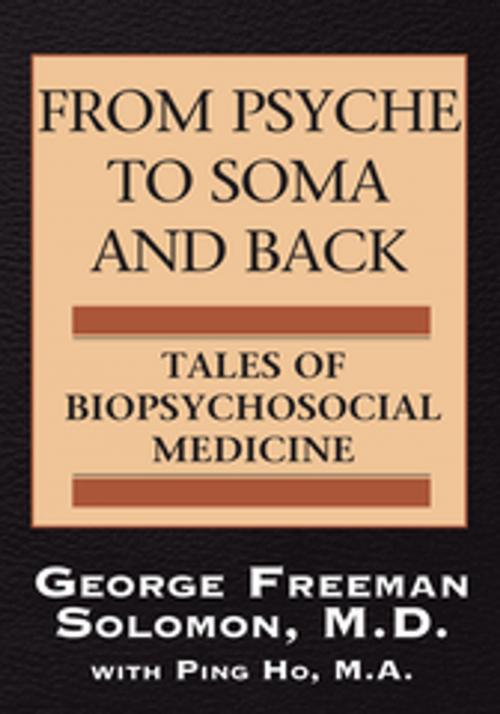| Author: | George Freeman Solomon M.D. | ISBN: | 9781462818013 |
| Publisher: | Xlibris US | Publication: | July 28, 2000 |
| Imprint: | Xlibris US | Language: | English |
| Author: | George Freeman Solomon M.D. |
| ISBN: | 9781462818013 |
| Publisher: | Xlibris US |
| Publication: | July 28, 2000 |
| Imprint: | Xlibris US |
| Language: | English |
FROM PSYCHE TO SOMA AND BACK
Tales of Biopsychosocial Medicine
by
George Freeman Solomon, M.D.
with Ping Ho, M.A.
From Psyche to Soma and Back subtitled Tales of Biopsychosocial Medicine is a scientific and personal adventure story, that of George Solomon, a pioneer of psychoneuroimmunology (the fast-growing field that studies interactions among brain, behavior, and immunity), who has always tended to tackle problems that others had not or would not. Dr. Solomon tries to solve mysteries, be they scientific or criminal, in bold, unconventional, and often controversial ways. His odyssey is an expos of conceptual narrowness and ethical shortcomings in clinical medicine, scientific research, criminology, and the military. Stories of real people remain in the forefront throughout. The through-line is the vicissitudes of human aggression. If one cannot stick up for oneself, one is prone to physical illness. If one takes out anger on others, one makes society sick. If one goes against ones own conscience to commit harm against others under social pressure, one may wind up with a mental disorder.
All of medicine as well as psychiatry and psychology is complexly biopsychosocial in nature, as Dr. George Engel pointed out in 1960. As might be added, so is criminology. To make more sense to the reader of a varied professional life that moves among these domains, sometimes contemporaneously, the book itself is divided into Biopsycho and Psychosocial sections. However, for the purpose of this outline of content, it makes sense to be descriptive chronologically even though it does not follow the order of the book. A list of chapters is appended. This description will be a first person narrative.
The groundwork for my thinking began with graduate and specialty medical education (Stanford, Washington University, UCSF). I repeatedly observed the inseparability of physical from psychological causes of physical and mental illnesses. There were the exceptionally nice unassertive people who, when deeply distressed, were getting sick with rheumatoid arthritis and other autoimmune diseases (when the immune system attacks the bodys own tissues). Could personality factors influence the immune system? Could Stress? (Later, I did quite well in betting my rheumatologist colleagues that, after a 20-minute non-medical chat, I could determine which patients with short term joint symptoms had rheumatoid arthritis over all possible causes.) There was the catatonic schizophrenic, whose three-month cure was triggered by her response to my own emotional grief and ended with my departure. What was going on at the dopamine receptors of her brain neurons during the improvement? It seemed to me that thoughts and feelings can change dopamine just as much as dopamine can change thoughts and feelings. Each clinical case I encountered seemed to solidify my belief in the mind-body connection.
I learned quickly that the only way that I would survive a two-year stint in the Army was to disguise my rebellious nature, a skill that has since served me well in academia. Stationed at Ft. McClellan near Anniston, Alabama (which I privately called Anus-town because of its then vicious racism). I was privy to Chemical Corps developments in lethal chemical and biological warfare. (This work was largely carried out by veterinarians because they do not take the Hippocratic Oath.) A main interest at that time was experimentation in the use of psychotomimetic compounds such as LSD as incapacitating agents, leading to my making some startling observations. I also served as psychiatrist to the Womens Army Corps Training Command at Ft. McClellan, where I made special efforts to try to thwart witch-hunts against ab
FROM PSYCHE TO SOMA AND BACK
Tales of Biopsychosocial Medicine
by
George Freeman Solomon, M.D.
with Ping Ho, M.A.
From Psyche to Soma and Back subtitled Tales of Biopsychosocial Medicine is a scientific and personal adventure story, that of George Solomon, a pioneer of psychoneuroimmunology (the fast-growing field that studies interactions among brain, behavior, and immunity), who has always tended to tackle problems that others had not or would not. Dr. Solomon tries to solve mysteries, be they scientific or criminal, in bold, unconventional, and often controversial ways. His odyssey is an expos of conceptual narrowness and ethical shortcomings in clinical medicine, scientific research, criminology, and the military. Stories of real people remain in the forefront throughout. The through-line is the vicissitudes of human aggression. If one cannot stick up for oneself, one is prone to physical illness. If one takes out anger on others, one makes society sick. If one goes against ones own conscience to commit harm against others under social pressure, one may wind up with a mental disorder.
All of medicine as well as psychiatry and psychology is complexly biopsychosocial in nature, as Dr. George Engel pointed out in 1960. As might be added, so is criminology. To make more sense to the reader of a varied professional life that moves among these domains, sometimes contemporaneously, the book itself is divided into Biopsycho and Psychosocial sections. However, for the purpose of this outline of content, it makes sense to be descriptive chronologically even though it does not follow the order of the book. A list of chapters is appended. This description will be a first person narrative.
The groundwork for my thinking began with graduate and specialty medical education (Stanford, Washington University, UCSF). I repeatedly observed the inseparability of physical from psychological causes of physical and mental illnesses. There were the exceptionally nice unassertive people who, when deeply distressed, were getting sick with rheumatoid arthritis and other autoimmune diseases (when the immune system attacks the bodys own tissues). Could personality factors influence the immune system? Could Stress? (Later, I did quite well in betting my rheumatologist colleagues that, after a 20-minute non-medical chat, I could determine which patients with short term joint symptoms had rheumatoid arthritis over all possible causes.) There was the catatonic schizophrenic, whose three-month cure was triggered by her response to my own emotional grief and ended with my departure. What was going on at the dopamine receptors of her brain neurons during the improvement? It seemed to me that thoughts and feelings can change dopamine just as much as dopamine can change thoughts and feelings. Each clinical case I encountered seemed to solidify my belief in the mind-body connection.
I learned quickly that the only way that I would survive a two-year stint in the Army was to disguise my rebellious nature, a skill that has since served me well in academia. Stationed at Ft. McClellan near Anniston, Alabama (which I privately called Anus-town because of its then vicious racism). I was privy to Chemical Corps developments in lethal chemical and biological warfare. (This work was largely carried out by veterinarians because they do not take the Hippocratic Oath.) A main interest at that time was experimentation in the use of psychotomimetic compounds such as LSD as incapacitating agents, leading to my making some startling observations. I also served as psychiatrist to the Womens Army Corps Training Command at Ft. McClellan, where I made special efforts to try to thwart witch-hunts against ab















